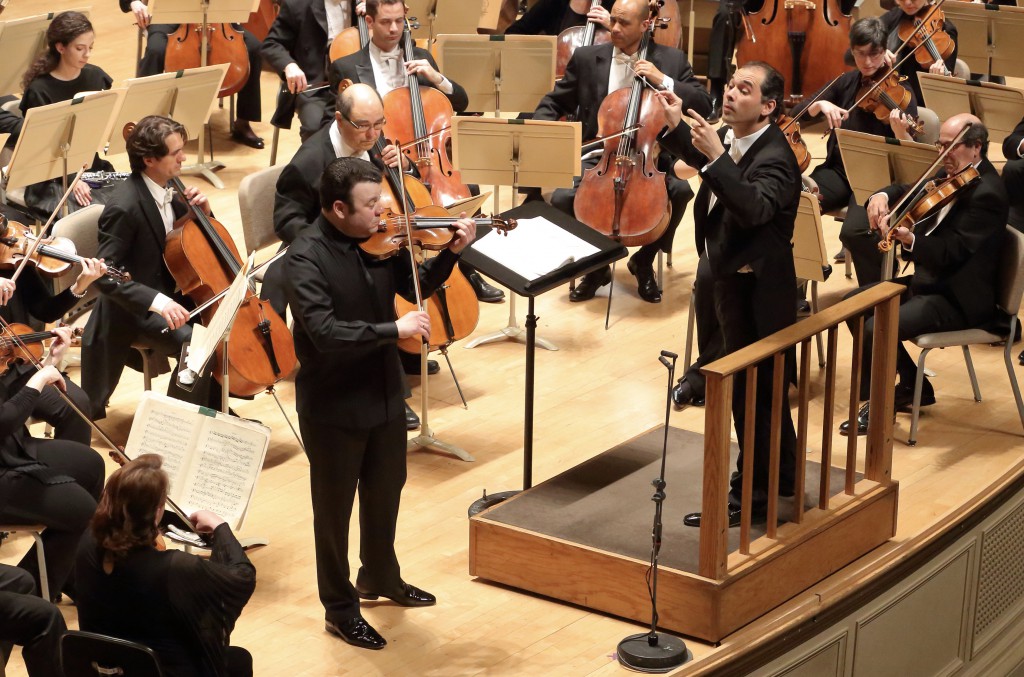Violinist Gluzman sparks Sokhiev’s BSO double bill of Brahms and Prokofiev

Vadim Gluzman and conductor Tugan Sokhiev joined the Boston Symphony Orchestra Thursday at Symphony Hall. Photo: Hilary Scott
Tugan Sokhiev’s weekend subscription series with the Boston Symphony Orchestra pairs favorites by Brahms and Prokofiev that did not disclose any hidden new depths in their first outing Thursday at Symphony Hall, but did make for a satisfying listen.
Prokofiev’s epic Symphony No. 5 dates from the last months of World War II and, at 45 minutes, it’s his lengthiest — an orchestral essay steeped in the style of his populist film scores for Eisenstein’s Alexander Nevsky and Ivan the Terrible. The four movements chart courses that are sometimes menacing, despairing and indomitable, but always expressively clear and accessible.
Music director of Moscow’s Bolshoi Theatre, Sokhiev led a performance of the Fifth that was unfailingly balletic, with the melodic line always at the forefront of his interpretation. Tempos were generally well calculated, except for a stretch in the middle of the second movement. Sokhiev also drew out many of the details in Prokofiev’s scoring — the striking writing for low instruments in the first movement, the several woodwind solos in the finale — and demonstrated a good understanding of the score’s motivic interconnectedness.
Yet this was a Prokofiev Five short on subtlety and symphonic weight. Climaxes tended to be blustery, with the brasses obliterating everything in their path and leaving little sense of the score’s overarching narrative.
Sokhiev’s approach was also surprisingly detached in places. The third movement, for instance, offered plenty of momentum but little passion. The delicate, brisk passagework that tees up the culmination of the finale came across as a furious muddle. The end result, expressively, was a wash: sometimes mighty in sound, but interpretively neither here nor there.
The ensemble opened with a big-boned account of Brahms’s 1878 Violin Concerto. The soloist, Vadim Gluzman, is known for a kind of old-world charisma in his playing, warming up lines with portamentos or intense vibrato. He deployed both to great effect in the gorgeous second movement.
In the outer movements, Gluzman’s tone was a bit chillier, though it carried through and over the orchestra easily enough. His playing is often note-perfect — and was for much of Thursday’s reading apart from a couple of fuzzy runs in the first-movement cadenza and in the middle of the finale. The concerto’s toughest gestures — an obstacle course of double-stop thirds, octaves, tenths, and triple-stop chords — were dispatched with effortless clarity and accuracy.
Sokhiev drew luxurious accompaniment from the orchestra. His tempos tended toward spacious — but not slow — and they sometimes trailed Gluzman’s forward-leaning sense of time. But that tiny separation created a welcome tension between soloist and ensemble in the first movement, especially. Balances throughout the work were well-judged. The multiple tempo transitions in the finale were precise, and the orchestral solos of the second movement — particularly those of principal oboe John Ferrillo and principal horn James Sommerville — shined.
Gluzman repaid the big ovation that followed with an encore of the “Sarabande” from Bach’s D-minor Partita.
The program will be repeated 1:30 p.m. Friday and 8 p.m. Saturday at Symphony Hall. bso.org; 888-266-1200.
Posted in Performances